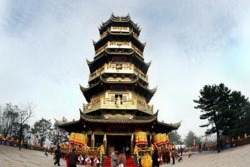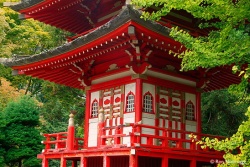The Origin of Pagodas
Ancient Chinese architecture boasts a rich variety of styles and high levels of construction. There were residences, official buildings, palaces, temples, altars, Gardens, Bridges, city walls and so on. Construction took the form of lou (multistoryed buildings), tai (terraces), ting (pavilions), ge (two-storey pavilions), xuan (verandas with windows), xie (pavilions or houses on terraces), wu (rooms along roofed corridors), etc. All these architectural forms were recorded in early documents of Chinese history. Pagodas, however, appeared relatively late in China. A Chinese term for Pagoda did not exist until the first century. The reason is that this new form of architecture was introduced to China only when Buddhism spread to the country.
The origin of pagodas, like that of Buddhism, can be traced to India. The relation between Buddhism and pagodas is explained in Buddhist literature, which says that pagodas were originally built for the purpose of preserving the remains of Sakyamuni, the founder of Buddhism. According to Buddhist scripture, when Sakyamuni's Body was cremated after his Death, his disciples discovered that his remains crystallized into unbreakable shiny beads. They were called Sarira, or Buddhist relics, as were his Hair, teeth and bones. Later, the remains of other Buddhist monks of high reputation were also called Sarira. Since more often than not, no such precious shiny beads could be found in the ashes of cremated Buddhist monks, other things, such as gold, silver and crystal objects or precious stones, were used instead.In Sanskrit Pagoda (or Stupa) meant tomb. Before the Pagoda was introduced to China, it had already had a considerable period of development in India. Beside serving as tombs, pagodas were built in grottoes or temples for offering sacrifices to people's ancestors. When the Indian word for Pagoda was first translated into Chinese, there were some twenty different versions. A renowned scholar of the Qing Dynasty, Ruan Yuan (1764-1849), summarized the history of the Pagoda's development in China in his essay "On the Characteristics of Pagodas" included in his Yan Jing Shi Ji (Collection of Essays from Yan Jing Studio). He said that during the Eastern Han Dynasty (25-220) both the Doctrine and preachers of Sakyamuni's religion were called futu. Their residence and the object of their worship was a building of seven or nine storeys, each surrounded by banisters. In Sanskrit this kind of building was called a Stupa. From the Jin Dynasty to the Southern and Northern Dynasties (265-589), when the Buddhist scriptures were translated into Chinese, there was no equivalent for the Hindu word for Pagoda in the Chinese Language, nor was there anything in China similar to the peculiar structure. Therefore, a new Chinese character was created to stand for the Buddhist tower, or Pagoda. The new character was ta, which first appeared in Zi Yuan (Essays on Chinese Characters) by Ge Hong (284-364), a scholar of the Eastern Jin Dynasty.
Ta is a much better translation than many other versions, such as futu or fotu, because it contains the radical meaning earth or soil, so it can be understood as an indication of a tomb. Some scholars believed that the character ta could be interpreted as an earthen tomb in which Buddha was buried, so it was a satisfactory equivalent for the word Pagoda.Buddhism spread in China not only because of its doctrines but also because of its concrete images, such as the religious sculptures and pagodas. It became a popular religion after the White Horse Temple was built near Luoyang, Henan Province, during the reign (58-75) of Emperor Ming of the Eastern Han Dynasty. Legend has it that the emperor once dreamed of a golden man more than three meters tall with a Halo over his head flying around his imperial palace. The next day the emperor called his ministers to court and asked them to interpret his dream. One of his ministers, Fu Yi, said, "In the West there is a God called Buddha. The golden man Your Majesty saw in your dream looked like him." So the emperor dispatched officials, Cai Yin, Qin Jing, Wang Zun and others, to India, Sri Lanka and Pakistan to learn the Doctrine of Buddhism. When they reached Central Asia, they met two Buddhist masters from India and acquired from them Buddhist scriptures and a statue of Buddha. They also invited the Indian Buddhists to China to lecture on Buddhism.When the Indian Buddhists arrived in Luoyang, then the capital of the Eastern Han Dynasty, Emperor Ming gave them a warm welcome and built a temple for them to live in the suburbs of Luoyang.Originally, the Chinese character si, meaning temple, stood for an official building that, in ancient China, ranked second only to the emperor's imperial palace. To show his respect for Buddhism, the emperor ordered that the residence of the Indian Buddhists be called a si, and ever since, Buddhist temples have been called that.
If pagodas were brought to China from India, what did the pagodas in India look like?
There used to be two kinds of pagodas in India: those used as tombs for Buddhist relics were called stupas; those serving as shrines or monuments were called temples. No relics were buried in the latter in most cases. Both kinds of pagodas underwent great changes in style after being introduced to China and became integrated with China's traditional architecture and culture.
The latter Pagoda was also called caitya in Sanskrit. In India they were originally grottoes dug out of stone cliffs. Religious sculptures were placed inside the Caves and small pagodas were built at the back as memorials. Usually space was cleared in front of the Pagoda for religious ceremonies. After being introduced to China, this kind of structure developed into the so-called grotto temple. Typical Chinese grottoes were much smaller than their Indian counterparts, so no religious ceremonies could be held inside. Usually a separate temple was built in front of or beside the grottoes to house Buddhist monks and for assemblies as well. The Pagoda placed at the back of an Indian grotto changed into an ornamental pillar either at the back or in the middle of the grotto. In fact, the Chinese temple was different from its Indian counterpart in both form and function. In India there was once a kind of special grotto called Vihara in which Buddhist monks lived. In the middle of such a grotto a square or rectangular platform was built for Buddhist preachers, to sit on to give lectures on Buddhism. At the back of the grotto a small Pagoda sculpture was erected in front of a small niche, serving as a place for praying. Along the front and side walls of the grotto many tiny rooms were dug out, each big enough for only one Monk to sleep in. Since each of the rooms was merely one square zhang (about ten square meters) in size, later the bedrooms of the abbots and monks in a Buddhist monastery were called fangzhang (meaning one square zhang) in Chinese. Of course, most Buddhist abbots actually lived in much bigger rooms. Such grotto temples, popular in the early development of Buddhism in India, were found in very few places in China. In fact, the Dunhuang Grottoes in Gansu Province may be the only place where remnants of similar structures can be found today.For instance, Caves No.267 to 271 at Dunhuang, dug during the Northern Liang period (397-439), used to be a group of related Caves, with Cave No. 268 as the center, to which Caves No. 267 and 270 on the southern wall and Caves No. 269 and 271 on the northern wall were attached. In fact, all four attached Caves were merely recesses big enough for only one person to sit with bent knee. It is believed that they were dug for the monks to sit in meditation, not for them to live in. Cave No. 285, dug during the Western Wei period (535-556), also contains four such recesses in its southern and northern walls, less than a square meter. On the ceiling of the main cave there is a painting of thirty-five monks sitting in meditation in some remote mountain Caves. From their size, the recesses as a place of meditation were only symbolic.The characteristics of these Caves show that the so-called Vihara underwent great changes after they were introduced to China from India.
We have learned that the pagodas designed as tombs for Buddhist relics were soon integrated with China's traditional architecture and culture and assumed Chinese characteristics after they were introduced to China from India. Most ancient pagodas still existing today in China are the so-called temple pagodas of Chinese style. Though they are called Sarira pagodas, sometimes Buddhist relics are not inside.
Few stupas believed to hold any relics of Sakyamuni have survived even in India or they have been destroyed and reconstructed repeatedly over the years retaining little of their original features. Among the earliest of such stupas is one built around the first century. It resembles a tomb with a domelike top in the middle. A pole with a dish-shaped object was erected on the top, and a platform surrounded by a balustrade served as the base. Stairs in front lead up to the platform. Four gateways face in four directions. On each side of the front gate is an ornamental column with exquisite relief sculptures of lions. They are similar to the ornamental columns erected in front of ancient tombs in China.Another Stupa featuring an inverted-bowl-shaped Body is located forty-five kilometers from the town of Gorakopa in northern India. It is believed to be the place where a famous Indian Buddhist monk attained Nirvana. Though it has been destroyed and reconstructed several times, it still resembles the style of the great Stupa mentioned earlier, which looks like a big tomb. The Lamaist dagobas in China have inherited this style.Great changes have also taken place in the structure of Indian pagodas. At Buddh Gaya in Gaya County, Bihar State, there is a Pagoda where Sakyamuni is believed to have awakened to the truth of Buddhism. Behind the Pagoda there is a Bodhi tree and under the tree is a solid rock seat, called vajrasana. Legend has it that Sakyamuni attained his Buddhahood while sitting on this seat. The structure of the Pagoda, therefore, is called the vajrasana style, which is completely different from that of the stupas described earlier. Pagodas of the vajrasana style also appeared in China. The earliest images of this kind of Pagoda are in a mural in Cave No. 285 of the Mogao Grottoes at Dunhuang, a work of the Northern Zhou Dynasty (557-581), and a small stone sculpture preserved in Chongfu Temple in Shuoxian County, Shanxi Province, believed to have been made in 454. The Dunhuang mural shows a square platform on which stand five pagodas; the one in the middle is much bigger and more spectacular than the ones at the four comers. Each of the five pagodas has seven storeys with a precious bead on top. Another small stone sculpture, made in 455 and found at the old site of Chongfu Temple, and a similar one made during the Tang Dynasty (618-907) and found in Nanchan Temple on Mount Wutai also bear this style, but the Vajrasana in the mural at Dunhuang more closely resembles existing structures than the small stone sculptures at Chongfu Temple.



